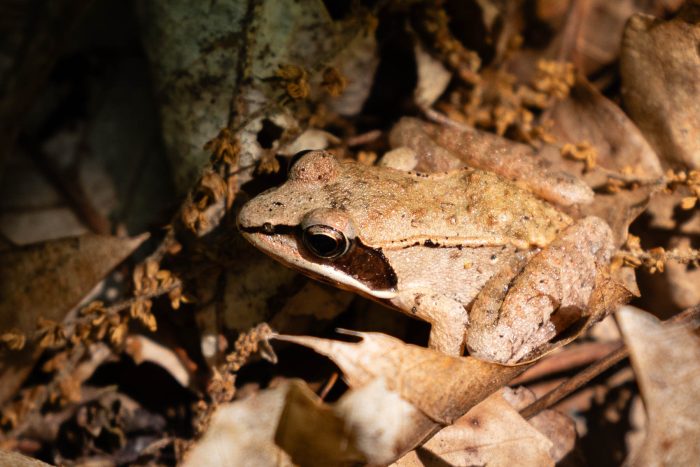Wood Frog
Lithobates sylvaticus
The wood frog is a small amphibian with a characteristic black marking on its face that resembles a robber’s mask. It can be found in forests and wetlands throughout the Chesapeake Bay region.
This section shows one large critter image at a time. Use the thumbnails that follow to select a specific image to display here.

This gallery contains a grid of small thumbnails. Selecting a thumbnail will change the main image in the preceding section.
Appearance
Wood frogs come in a variety of colors, from brown to green to gray. They have a white underside and upper lip. Wood frogs are known for a characteristic black marking on their face that resembles a robber’s mask. They also have two raised skin ridges, called dorsolateral folds, that run from their eyes down their back. Wood frogs range from 1.5 to three inches in length. Females are larger than males.
Feeding
Adults feed mostly on invertebrates, including spiders, beetles, slugs and snails. Tadpoles eat algae or other amphibian eggs.
Predators
Adult wood frogs are eaten by larger frogs, snakes, herons and mammals, like skunks and raccoons. The older tadpoles and adults develop poison glands to ward off predators and use their coloring to blend in with the forest.
Voice
Males make quacking or chuckling calls during mating season. Outside of mating season, wood frogs are generally silent. They have a high, loud cry they use to try to startle predators into releasing them if captured.
Reproduction and life cycle
Wood frogs are some of the first frogs to start breeding in the spring. Their mating season starts with the first warm spring rain and runs from March through May. Outside of breeding season, they are solitary animals. They visit vernal pools to breed. Vernal pools are small, shallow forest ponds, fed by melting snow, rain or groundwater, but dry up during certain times of the year.
Vernal pools are a good place for amphibians to lay eggs, because they don’t support any fish that might eat them. After mating, females will lay egg masses made up of 1,000 to 3,000 eggs in the vernal pool. The eggs mass will flatten and float to the surface, camouflaged by the green jelly surrounding the eggs.
The eggs take between a week and a month to hatch, depending on the temperature—eggs laid earlier in the season, when the weather is colder, will take longer. The tadpoles begin metamorphosis to adult frogs at two months. Males reach sexual maturity at one or two years old, while females take three years. Females often live longer than the males.
Did you know?
- The wood frog’s range extends further north than any other North American reptile or amphibian.
- Its scientific name, Lithobates sylvanticus, comes from both Greek and Latin. Litho is Greek for stone, bates means “one that walks or haunts” and sylvaticus is Latin for “amidst the trees.”
- Wood frog tadpoles have an uncanny ability to identify their relatives and often congregate together in their vernal pools for protection.
- These frogs are diurnal, meaning that they are active during the day.
- Wood frogs cannot identify males from females by sight. During breeding season, males will grab any wood frog it sees to try to mate. Once it is holding the other frog, it can tell from the size if the frog is a female full of eggs—it releases males or thin females that have already spawned.
- During winter hibernation, the wood frog is able to freeze nearly half of its body. Ice crystals form within its skin, stopping its heartbeat, breathing and blood flow.
Sources and additional information
- Animal Diversity Web: Lithobates sylvaticus – University of Michigan
- Wildlife Guide: Wood Frog – National Wildlife Federation
- Amphibians: Wood Frog – Virginia Herpetological Society
- Field Guide to Maryland’s Frogs and Toads: Wood Frog – Maryland Department of Natural Resources
